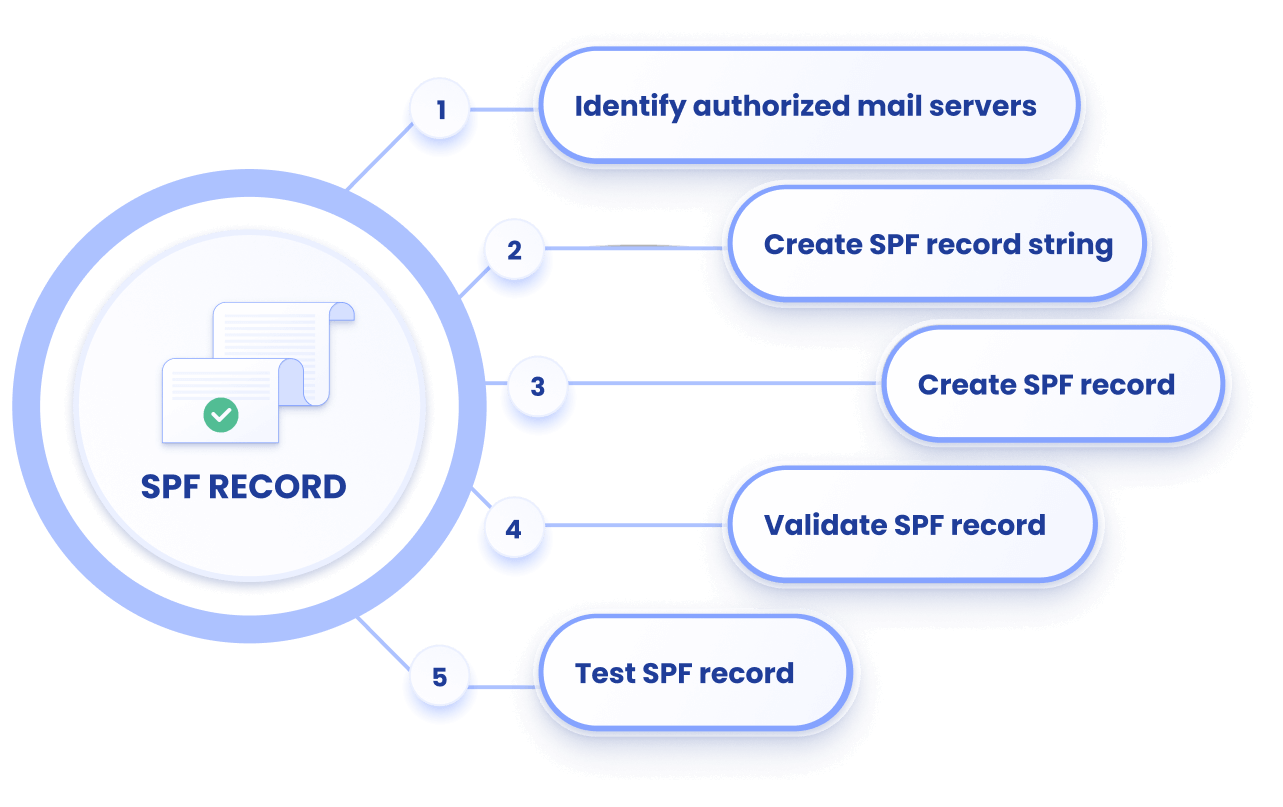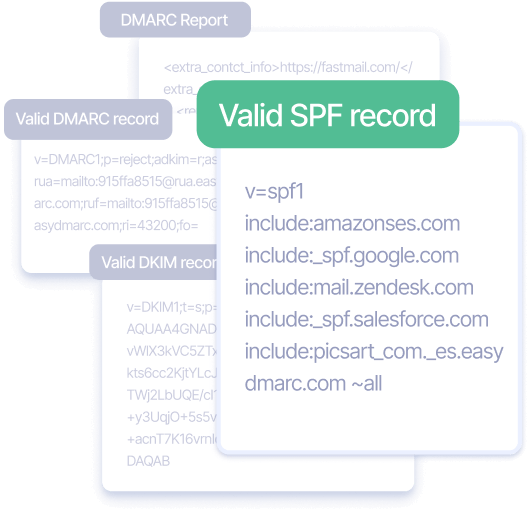SPF Record Generator
Generate valid SPF records for your domain with EasyDMARC’s SPF record creator
What is an SPF Record?
A Sender Policy Framework (SPF) record is an email authentication tool that helps protect your domain from email spoofing and phishing. It acts as a gatekeeper, defining which mail servers and IP addresses are authorized to send emails on behalf of your domain. Published in your domain's DNS, an SPF record contains a list of trusted sources permitted to use your domain name.
This mechanism helps prevent spoofing, where attackers forge the "from" address of an email. When an email is sent, the recipient's server checks if the sender's IP address is on the authorized list in your SPF record. If it matches, the email passes authentication; otherwise, it may be flagged as fraudulent and rejected or marked as spam. This reduces the risk of your domain being misused for phishing or spam campaigns.
SPF also improves email deliverability rates. By ensuring only authorized sources send emails, you build trust with receiving mail servers. This increases the likelihood of your legitimate emails reaching inboxes instead of being filtered into spam folders. For the best protection against email threats, SPF must be combined with protocols like DKIM and DMARC.

How to Generate an SPF Record
To generate an SPF record, you must first identify all the email sources authorized to send emails on your domain's behalf. This includes your internal mail servers, third-party providers, web servers, and any other authorized entities permitted to use your domain in the "from" field of emails. Compiling this list ensures that only trusted sources are included in your SPF record, which acts as a safeguard against unauthorized use of your domain.
Once you have a comprehensive list of these sending sources and their corresponding IP addresses, you can create the SPF record. To streamline this process, we recommend using our SPF record generator tool. By inputting the necessary information into the generator, you can quickly create a valid SPF record for your domain and minimize errors.
If your domain already has an SPF record, use EasyDMARC's free SPF Checker to ensure it is updated and accurate; only one SPF record is allowed per domain.
After generating the SPF record, you then publish it as a TXT entry in your domain’s DNS settings via your provider’s control panel. Once published, test the record using our SPF Checker to confirm all authorized sources are properly listed and there are no errors.

Get Valid SPF Records with EasyDMARC's SPF Record Builder
EasyDMARC’s SPF Generator is a free online service that allows you to quickly and easily generate SPF records. With just a few simple steps, you can create a customized SPF record that will protect your domain infrastructure from spoofing.
Generating an SPF record with EasyDMARC’s SPF Record Generator is simple; just enter your domain and click “Generate.” While you can finetune all the components before generating the record, you don’t have to. This means that using the SPF record creator is easy both for beginners and experts alike.
Setting up a valid SPF record is the first step towards email authentication. So, get started with our SPF Record Generator and get one step closer to DMARC compliance.

What Is EasyDMARC’s SPF Record Generator?
Our SPF Record Generator tool allows you to create a valid SPF record. Generally, SPF provides mechanisms, qualifiers, and modifiers to allow domain administrators to specify IP addresses in a highly flexible way. Our SPF Record Generator tool wizard was designed to make this process fast and easy. Read more about how to create an SPF record here.
How Is an SPF Record Structured?
An SPF record has a list of tags and values. The structure of an SPF record looks like this:
v=spf1 [mechanism] [modifier] [all]
It should always start with version v=spf1, and it should always end with all tags.
An SPF record is composed of four parts.
- The first is a version identifier that tells the receiving mail server what version of SPF is being used.
- The second is a list of mechanisms, which are the different parts of the SPF record that determine how a mail server should handle mail sent from a given email address.
- The third part is a list of modifiers, which determine how the server should handle mail if it comes from an IP address or domain name that is not on the list of mechanisms.
- Finally, the fourth part is the all mechanism, which is the default action for mail that does not match any other mechanisms in the record.
How To Publish a Generated SPF Record in DNS?
The SPF record is a TXT record, so you need to publish it in your DNS as a TXT record as follows
- Navigate to the DNS for your desired domain
- Create a new TXT Record
- Write the name of the domain in the “Host” field
- Enter the generated SPF record in the “Value” or “Target” column
What Are the Limitations of an SPF Record?
The SPF record has several limitations:
- 10 DNS lookup limit. If you exceed this limit, it will result in a permerror
- No prevention of the From: address spoofing attacks
- No reporting to evaluate your SPF “health”

